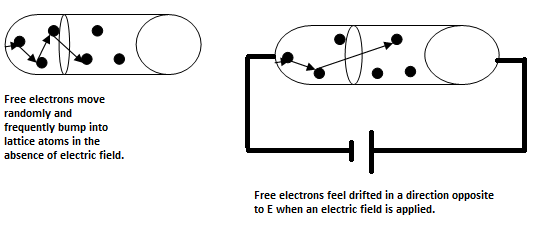Question 2: Explain the electronic current in a metallic wire as due to the drift of free electrons in the wire.
ANSWER
Definition of current
“The average velocity with which free electrons are getting drifted in a metallic conductor under the influence of an electric field is called drift velocity, denoted by Vd.”
A metallic wire consists of a large number of free electrons. They move in random directions within the body of the metal. However, on the average, equal number of electrons move along each direction and the net current in the wire is thus zero. Saying more strictly, the free electrons do not move from one end of the metallic wire to the other end in a straight line. They constantly, bump into atoms and other electrons and this makes their path very inconsistent.

If the ends of the wire are connected to some source of potential difference, an electric field is set up at every point within the wire. Consequently, the electrons feel a force in the direction opposite to the direction of the electric intensity. As a result of this force, and collisions with the lattice atoms, the electrons start drifting with a certain velocity, called drift velocity. Though they are deflected left and right or even backwards, eventually they make to the other end.
Although their instantaneous velocity is high, it will take them much longer to battle their way to the other end of the conductor. So the drift velocity is very low.
Drift velocity is found to be of the order of 10-5 m/s whereas the velocity of a free electron is several hundred kilometers per second.

Pingback:ohms-law-scope-and-validity – msa
Pingback:steady-current-as-flow-of-ve-ve-charges – msa
Pingback:index-cqs-ch13-p12 – msa